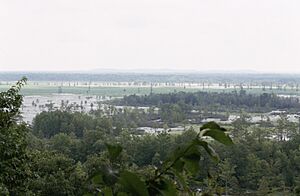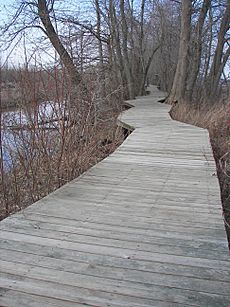Mingo National Wildlife Refuge facts for kids
Quick facts for kids Mingo National Wildlife Refuge |
|
|---|---|
|
IUCN Category IV (Habitat/Species Management Area)
|
|

Mingo National Wildlife Refuge, May 2013
|
|
| Location | Stoddard / Wayne counties, Missouri, USA |
| Nearest city | Puxico, Missouri |
| Area | 21,676 acres (87.7 km2) |
| Established | 1944 |
| Visitors | 70,000 (in 2004) |
| Governing body | U.S. Fish and Wildlife Service |
| Website | Mingo National Wildlife Refuge |
The Mingo National Wildlife Refuge is a special place in Missouri, covering about 21,676 acres (87.7 square kilometers). It's located in parts of Stoddard and Wayne counties. This refuge was created to protect important forests and offer a safe home for ducks, geese, and other birds that travel long distances. It's named after the Mingo tribe, a Native American group.
The refuge is a key spot along the Mississippi Flyway, which is like a superhighway in the sky for birds migrating between their summer and winter homes. Here, they find places to nest, eat, raise their young, and rest. A small team of nine people helps manage and care for this important area.
Contents
History of Mingo National Wildlife Refuge
The land where Mingo National Wildlife Refuge now sits became part of the United States in 1804. This happened after the Louisiana Purchase, a huge land deal. Back then, very few people lived in this swampy area of Missouri. It was considered hard to reach.
Early Settlers and Lumber Industry
Settlers first came to this swamp because of its huge cypress and tupelo trees. These giant trees were perfect for making railroad ties and building materials. A big lumber company, T.J. Moss Tie Company, used many trees from the swamp. By 1888, it was the largest company making railroad ties in Missouri.
A huge sawmill, which some say was the biggest in America at one time, operated near Puxico. The lumber business was busiest in this area between 1900 and 1910. Missouri's "Bootheel" region, where Mingo is, was the top lumber producer in the state. However, by 1935, most of the big lumber operations had stopped because the giant trees were gone.
Draining the Swamp for Farming
After the trees were cut, powerful lumber companies wanted to drain the swamp. They hoped to turn the land into farms and make more money. The Missouri State Legislature passed a law that allowed "drainage districts" to form. These districts could get money by selling bonds to pay for big drainage projects.
In 1914, the Mingo Drainage District was formed. Over $1 million was spent to make the Mingo Swamp good for farming. Workers dug seven major ditches that ran north to south. These ditches helped move water from the swamp into the St. Francis River. Today, the refuge still uses these same ditches to control and manage water.
The Great Depression and Land Decline
During the Great Depression in the 1930s, land values dropped sharply. Many large landowners, including lumber companies, stopped paying taxes on their land. They didn't want to keep investing in land that wasn't making money. Because of this, many drainage districts, including Mingo, couldn't pay back their loans.
The attempts to drain Mingo weren't fully successful. The St. Francis River often flooded the area. Also, the soil wasn't as good for farming as in other parts of the Bootheel. The Mingo District went broke.
The land became a free-for-all. People cut down any remaining trees without caring who owned them. Cattle and hogs roamed freely across the swamp. To keep the land grassy, it was often burned, sometimes several times a year. This caused a lot of damage.
Wildlife also suffered. People hunted waterfowl without limits. Animals like beaver and deer disappeared, and wild turkeys almost vanished from the swamp.
Establishing the Refuge and Restoration
In 1945, the United States Fish and Wildlife Service bought 21,676 acres of the Mingo Swamp. They created the Mingo National Wildlife Refuge. The land was in terrible shape. In just 50 years, a beautiful swamp full of plants and animals had become a burnt, damaged wasteland.
But with careful management, most of the natural plants and animals have returned. Native trees have replaced much of the brush. If you take a canoe trip down the Mingo River today, you would hardly know how badly the land was treated in the past. Deer, wild turkey, bobcats, and beaver are now plentiful.
The refuge is now doing its main job: providing food and shelter for migratory waterfowl. In 1976, the Mingo Wilderness Area was created within the refuge. This helps make sure this special place is protected for future generations.
Land and Landscape of Mingo Refuge
About 25,000 years ago, the Mississippi River flowed between the Ozark Mountains and a high area called Crowley's Ridge. Then, about 18,000 years ago, the river changed its path. It cut through Crowley's Ridge and joined the Ohio River further north. The old riverbed that was left behind became a rich and fertile swamp.
The Mingo Refuge sits in this old river channel. The Ozark Mountains are to its west, and Crowley's Ridge is to its east.
Unique Forest and Natural Areas
The refuge holds the largest remaining piece of bottomland forest in Missouri's Bootheel. This forest covers about 15,000 acres (61 square kilometers). Originally, there were 2.5 million acres of this type of forest in the Bootheel.
Mingo also has seven natural areas and 99 archaeological sites. These sites show signs of human activity from long ago. About 8,000 acres (32 square kilometers) of the refuge are part of the Mingo Wilderness. This means this area is kept as wild as possible.
Right next to the refuge, on its north and east sides, is the Duck Creek Conservation Area. This area, managed by the Missouri Department of Conservation, covers 6,190 acres (25 square kilometers).
Wildlife and Protected Species
Mingo's main goal is to protect its wild areas and provide important homes for migratory waterfowl. Since it's in the middle of the busy Mississippi Flyway, it's a vital resting and feeding spot for birds flying south for the winter.
Birds of Mingo Refuge
Mingo is home to many kinds of birds. Besides ducks and geese that live there all year, it hosts many migrating birds. These include ducks, geese, shorebirds, gulls, terns, loons, grebes, pelicans, cormorants, herons, bitterns, ibises, rails, coots, and swans. Over 95 different types of migratory waterfowl have been seen at Mingo.
By carefully managing water levels throughout the year, the refuge makes sure migrating birds have enough food and places to rest. In winter, Mingo provides a home for over 150,000 ducks and 75,000 geese.
More than 250 different bird species have been seen at Mingo. This list includes the peregrine falcon, the very rare whooping crane, and the bald eagle, which was once threatened but is now recovering.
Other Animals of Mingo Refuge
Because Mingo has different types of habitats, from swampy lowlands to upland forests, it's home to many animals. There are over 38 types of mammals, 23 types of amphibians (like frogs and salamanders), and 37 types of reptiles (like snakes and turtles).
Many of these animals are abundant but rarely seen. This is because much of the refuge is protected wilderness and hard for people to reach. This helps keep the animals mostly untouched by human activity.
Things to Do at Mingo Refuge
Mingo National Wildlife Refuge welcomes visitors to enjoy nature. You can watch wildlife and take photos. There are 12 miles of roads open every day, with four spots to observe animals and one boardwalk nature trail.
A 25-mile scenic auto tour route is open during April and May to see spring wildflowers and migrating songbirds. It's also open in October and November for beautiful fall colors and waterfowl migration.
Outdoor Activities
Some hunting is allowed in certain areas for deer, wild turkey, squirrel, and waterfowl. Fishing is also popular on the refuge. You can catch bass, crappie, bluegill, and catfish.
Trails for Exploring
The refuge has three main trails and over 50 miles of unmarked trails.
Boardwalk Nature Trail
The Boardwalk Nature Trail lets you explore the Mingo Swamp without getting wet! It's a one-mile (1.6-kilometer) loop trail that goes through the bottomland hardwood swamp. You can pick up a guide at the parking lot to learn about what you're seeing. This path is also good for wheelchairs.
Bluff Trail
The Bluff Trail is about a quarter-mile long and starts at the Visitor Center. It connects to the Boardwalk. This trail is great for seeing wildflowers in the spring. It also offers a cool view of the steep limestone bluffs that border the swamp. These bluffs were once the edge of the Mississippi River. This trail is considered "challenging" for hikers.
Hartz Pond Trail
The Hartz Pond Trail also starts at the Visitor Center parking lot. It leads to Hartz Pond, a small pond where you can have a picnic. Kids can also fish here. Hartz Pond is often used as an outdoor classroom for environmental education.
Other Hiking Areas
Besides these main trails, Mingo has over 50 miles (80 kilometers) of other roads, dikes, and levees that are open for walking. These areas are not open to cars but are open to hikers from March 15 to September 30. It's a good idea to check with the Visitor Center before you go to get directions and learn about any special rules.
Images for kids









